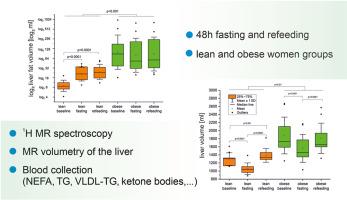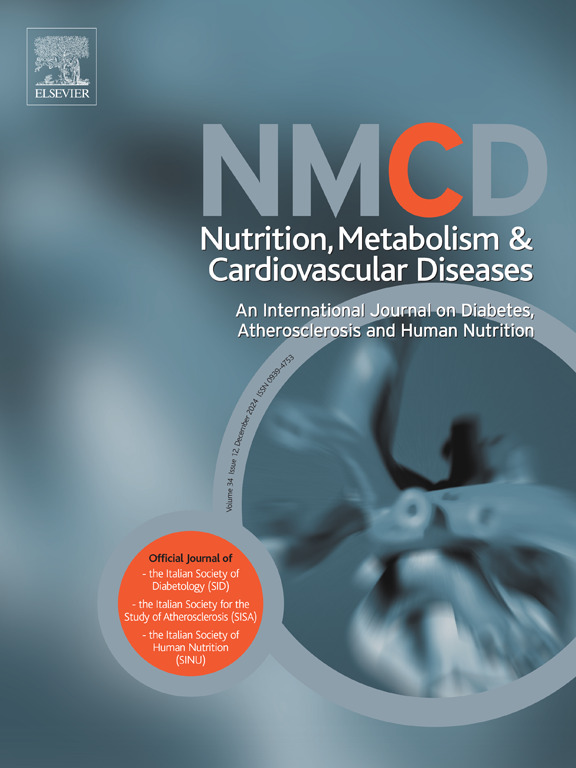Liver fat response to two days fasting and two days isocaloric high-carbohydrate refeeding in lean and obese women
IF 3.3
3区 医学
Q2 CARDIAC & CARDIOVASCULAR SYSTEMS
Nutrition Metabolism and Cardiovascular Diseases
Pub Date : 2024-10-01
DOI:10.1016/j.numecd.2024.09.030
引用次数: 0
Abstract
Background and aims
Prolonged fasting, which leads to the mobilization of fat from adipose tissue, can result in the development of hepatosteatosis. However, it is not yet known whether the accumulation of fat in the liver after fasting can be affected by concurrent obesity. Therefore, this study aimed to assess how excessive adiposity influences changes in liver fat content induced by fasting and subsequent refeeding.
Methods and results
Ten lean women and eleven women with obesity (age: 36.4 ± 7.9 and 34.5 ± 7.9 years, BMI: 21.4 ± 1.7 and 34.5 ± 4.8 kg/m2) underwent a 60-h fasting period followed by 2 days of isocaloric high-carbohydrate refeeding. Magnetic resonance spectroscopy (MRS) examinations of liver were conducted at baseline, after 48 h of fasting, and at the end of refeeding period. Hepatic fat content (HFC) increased in lean women after fasting, whereas no statistically significant change in HFC was observed in women with obesity. Additionally, fasting led to significant reductions in liver volume in both groups, likely attributable to glycogen depletion, with subsequent restoration upon refeeding. Notably, changes in hepatic fat volume (HFV) rather than HFC inversely correlated with baseline liver fat content and HOMA-IR.
Conclusion
We demonstrated that prolonged fasting results in accumulation of fat in the liver in lean subjects only and that this accumulation is inversely related to baseline fat content and insulin resistance. Moreover, the study underscored the importance of evaluating hepatic fat volume rather than hepatic fat content in studies that involve considerable changes in hepatic lean volume.

瘦弱和肥胖女性对两天禁食和两天等热量高碳水化合物进食的肝脏脂肪反应。
背景和目的:长期禁食会导致脂肪组织中的脂肪被动员起来,从而导致肝脂肪变性。然而,禁食后脂肪在肝脏中的积聚是否会受到并发肥胖症的影响,目前尚不清楚。因此,本研究旨在评估过度肥胖如何影响禁食和随后再进食引起的肝脏脂肪含量变化:10 名瘦弱女性和 11 名肥胖女性(年龄:36.4 ± 7.9 岁和 34.5 ± 7.9 岁,体重指数:21.4 ± 1.7 千克/平方米和 34.5 ± 4.8 千克/平方米)进行了 60 小时的禁食,随后进行了为期 2 天的等热量高碳水化合物进食。分别在基线期、禁食 48 小时后和进食期结束时对肝脏进行了磁共振光谱(MRS)检查。禁食后,瘦弱女性的肝脏脂肪含量(HFC)增加,而肥胖女性的肝脏脂肪含量在统计学上没有明显变化。此外,禁食还导致两组女性的肝脏体积显著缩小,这可能是由于糖原耗竭所致,随后在进食后恢复。值得注意的是,肝脏脂肪体积(HFV)而非肝脏脂肪含量的变化与基线肝脏脂肪含量和 HOMA-IR 成反比:我们的研究表明,长期禁食只会导致瘦人肝脏中脂肪的积累,而且这种积累与基线脂肪含量和胰岛素抵抗成反比。此外,该研究还强调了在涉及肝脏瘦肉体积发生巨大变化的研究中,评估肝脏脂肪体积而非肝脏脂肪含量的重要性。
本文章由计算机程序翻译,如有差异,请以英文原文为准。
求助全文
约1分钟内获得全文
求助全文
来源期刊
CiteScore
6.80
自引率
2.60%
发文量
332
审稿时长
57 days
期刊介绍:
Nutrition, Metabolism & Cardiovascular Diseases is a forum designed to focus on the powerful interplay between nutritional and metabolic alterations, and cardiovascular disorders. It aims to be a highly qualified tool to help refine strategies against the nutrition-related epidemics of metabolic and cardiovascular diseases. By presenting original clinical and experimental findings, it introduces readers and authors into a rapidly developing area of clinical and preventive medicine, including also vascular biology. Of particular concern are the origins, the mechanisms and the means to prevent and control diabetes, atherosclerosis, hypertension, and other nutrition-related diseases.

 求助内容:
求助内容: 应助结果提醒方式:
应助结果提醒方式:


